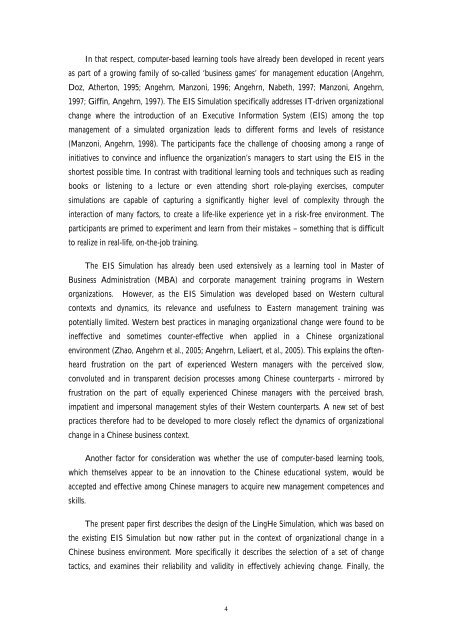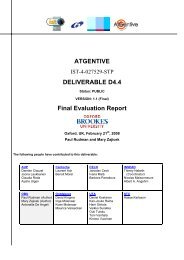LingHe Simulation - INSEAD CALT
LingHe Simulation - INSEAD CALT
LingHe Simulation - INSEAD CALT
Create successful ePaper yourself
Turn your PDF publications into a flip-book with our unique Google optimized e-Paper software.
In that respect, computer-based learning tools have already been developed in recent years<br />
as part of a growing family of so-called ‘business games’ for management education (Angehrn,<br />
Doz, Atherton, 1995; Angehrn, Manzoni, 1996; Angehrn, Nabeth, 1997; Manzoni, Angehrn,<br />
1997; Giffin, Angehrn, 1997). The EIS <strong>Simulation</strong> specifically addresses IT-driven organizational<br />
change where the introduction of an Executive Information System (EIS) among the top<br />
management of a simulated organization leads to different forms and levels of resistance<br />
(Manzoni, Angehrn, 1998). The participants face the challenge of choosing among a range of<br />
initiatives to convince and influence the organization’s managers to start using the EIS in the<br />
shortest possible time. In contrast with traditional learning tools and techniques such as reading<br />
books or listening to a lecture or even attending short role-playing exercises, computer<br />
simulations are capable of capturing a significantly higher level of complexity through the<br />
interaction of many factors, to create a life-like experience yet in a risk-free environment. The<br />
participants are primed to experiment and learn from their mistakes – something that is difficult<br />
to realize in real-life, on-the-job training.<br />
The EIS <strong>Simulation</strong> has already been used extensively as a learning tool in Master of<br />
Business Administration (MBA) and corporate management training programs in Western<br />
organizations. However, as the EIS <strong>Simulation</strong> was developed based on Western cultural<br />
contexts and dynamics, its relevance and usefulness to Eastern management training was<br />
potentially limited. Western best practices in managing organizational change were found to be<br />
ineffective and sometimes counter-effective when applied in a Chinese organizational<br />
environment (Zhao, Angehrn et al., 2005; Angehrn, Leliaert, et al., 2005). This explains the oftenheard<br />
frustration on the part of experienced Western managers with the perceived slow,<br />
convoluted and in transparent decision processes among Chinese counterparts - mirrored by<br />
frustration on the part of equally experienced Chinese managers with the perceived brash,<br />
impatient and impersonal management styles of their Western counterparts. A new set of best<br />
practices therefore had to be developed to more closely reflect the dynamics of organizational<br />
change in a Chinese business context.<br />
Another factor for consideration was whether the use of computer-based learning tools,<br />
which themselves appear to be an innovation to the Chinese educational system, would be<br />
accepted and effective among Chinese managers to acquire new management competences and<br />
skills.<br />
The present paper first describes the design of the <strong>LingHe</strong> <strong>Simulation</strong>, which was based on<br />
the existing EIS <strong>Simulation</strong> but now rather put in the context of organizational change in a<br />
Chinese business environment. More specifically it describes the selection of a set of change<br />
tactics, and examines their reliability and validity in effectively achieving change. Finally, the<br />
4
















